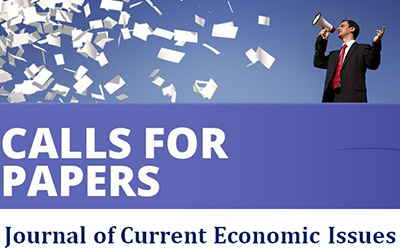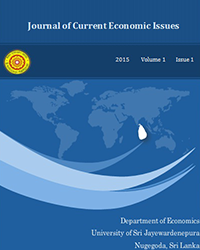

The Journal of Current Economic Issues (JCEI) is a bi-annual refereed journal and fully devoted for “Current Economic Issues” with special emphasis to Sri Lanka. JCEI aims to reaffirm top-notch research to encourage and publish issue-oriented research papers. To ensure high-quality publications, all papers are subject to rigorous screening process and peer-review by national and international scholars with strong academic and research background in their areas of expertise.
Authors are invited to submit original full-length papers.
VOL 1 ISSUE 1, 1st January, 2015
Deadlines for Submission of Papers : 31st October, 2014
Authors should submit an electronic copy in MS-Word format by e-mail, with full contact details to the chief editor Dr. Shirantha Heenkenda (shiran@sjp.ac.lk).
The Journal is published in volumes with two issues i.e. January-June and July December. A full double-blind review process is used with the following steps.
• Paper is sent to two reviewers for evaluation.
• Recommendations of the reviewers determine the acceptance of a paper with or without changes or rejection.
• Once a paper is accepted subject to minor or major changes, the same reviewers will be used to ensure the acceptability of the changes.
• Once a paper finally accepted by the reviewers, author/s will be informed about the acceptance of the paper and the possible date of publication.
One hard copy of the journal for each author will be sent after the publication.
The authors are advised to follow the author guidelines given below (from A to G) in preparing the manuscripts.
A. Language
The language of the manuscript must be in English (either American or British standard, but not the mixture of both).
B. Length of Paper
The length of the paper should not exceed 20 pages. Paper containing more than 25 pages words will be returned to the author(s) to abridge. Articles should be typed in double-space (including footnotes and references) on one side of the paper only (preferably A4) with wide margins. Authors are urged to write as concisely as possible, but not at the expense of clarity.
C. Title Page
Title page is a separated page before the text. It should include the following information:
Title:
Title should be concise and informative. Try to avoid abbreviations and formulae where possible.
Author’s Names and Affiliations:
Please indicate the given name and family name clearly. Present the authors’ affiliation addresses (where the actual work was done) below the names. Indicate all affiliations with a lower-case superscript letter immediately after the author’s name and in front of the appropriate address. Provide the full postal address of each affiliation, including the country name, and, if available, the e-mail address, and telephone number of each author.
Corresponding Author:
Clearly indicate who is willing to handle correspondence at all stages of refereeing, publication and also post-publication. Ensure that telephone numbers (with country and area code) are provided in addition to the e-mail address and the complete postal address.
Sponsoring Information:
If the research is sponsored or supported by an organization, please indicate it.
Abstract:
A concise and factual abstract is required (maximum length of 200 words). The abstract should state briefly the purpose of the research, the principal results and major conclusions. An abstract is often presented separate from the article, so it must be able to stand alone. References should therefore be avoided, but if essential, they must be cited in full, without reference to the reference list.
Keywords:
Immediately after the abstract, provide a maximum of 8 keywords, avoiding general and plural terms and multiple concepts (avoid, for example, ‘and’, ‘of’).
D. Subdivision of the Article
Divide your article into clearly defined and numbered sections. Subsections should be numbered 1, 2. (then 1.1, 1.1.1, 1.1.2), 1.2, etc. The abstract is not included in section numbering.
E. Table and Figures
Present tables and figures at the end of the article. Please note that the article will be published in black and white.
F. Classification according to the system of the journal of Economic Literature (JEL):
(The JEL codes are available from: http://www.aeaweb.org/journal/jel_class_system.html)
G. Reference Method and Style:
Author(s) should follow the latest edition of APA (American Psychological Association) style in referencing. Please visit www.apastyle.org
